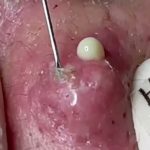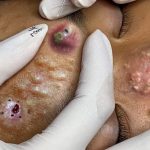Extracting big cystic acne or blackheads can be tempting, but it should be approached with caution to avoid skin damage, infection, or scarring. Here’s a breakdown of how professionals typically manage these issues, and safer steps if you’re attempting care at home.
🔴 Important Note:
-
Cystic acne is deep, inflamed, and often doesn’t have a “head” to extract. It’s not safe to extract at home.
-
Big blackheads, especially dilated pores of Winer, can sometimes be removed manually, but gently and hygienically.
✅ Best Approach: Professional Extraction (Recommended)
-
Dermatologist or Esthetician Visit:
-
Uses sterile tools (comedone extractors)
-
Applies steam or warm compresses
-
Extracts under clean conditions
-
May use cortisone shots for cystic acne
-
-
Medical Treatments:
-
Prescription topicals (retinoids, benzoyl peroxide, antibiotics)
-
Oral medications for cystic acne (Accutane, spironolactone)
-
⚠️ If Doing It at Home (Blackheads Only):
Only do this with surface-level blackheads, and never on cystic acne.
Step-by-Step Blackhead Extraction at Home:
-
Wash Your Face:
-
Use a gentle cleanser to remove dirt and oil.
-
-
Steam Your Face (5–10 minutes):
-
Boil water, pour in a bowl, drape towel over head.
-
This opens up pores and softens debris.
-
-
Use Clean Hands or Tools:
-
Wrap fingers in tissue or use a sterilized comedone extractor.
-
Gently press down on both sides of the blackhead.
-
If it doesn’t come out easily, don’t force it.
-
-
Aftercare:
-
Rinse with cool water.
-
Apply a soothing toner (like witch hazel) or a salicylic acid product.
-
Avoid touching or applying heavy makeup right after.
-
❌ Never Do This:
-
Try to extract deep cysts – they are under the skin and need medical care.
-
Use needles, pins, or nails to dig into your skin.
-
Overdo extractions — it can cause scarring and worsen acne.
🧴 Suggested Products (for regular care):
-
Salicylic Acid Cleanser (e.g., CeraVe, Neutrogena)
-
Benzoyl Peroxide Spot Treatment
-
Retinoids (over-the-counter: adapalene; or Rx: tretinoin)
-
Clay Masks (like bentonite or kaolin)
⚠️ Cystic Acne: Extraction Is Not Recommended
Cystic acne is a severe form of acne characterized by large, painful, deep-seated lumps beneath the skin’s surface. Attempting to extract these cysts at home is not advisable due to several risks:
-
Deep inflammation: Cystic acne lacks a visible “head,” making it difficult to extract and increasing the likelihood of pushing the infection deeper.
-
Infection risk: Improper handling can introduce bacteria, leading to further complications.
-
Scarring: Forceful or incorrect extraction can result in permanent scarring.
Professional Treatment: Dermatologists may use sterile techniques, such as corticosteroid injections, to reduce inflammation and promote healing. It’s essential to consult a healthcare professional for appropriate treatment options.
🟤 Blackheads: Safer Extraction Methods
Blackheads are open comedones formed when hair follicles become clogged with oil and dead skin cells. While it’s generally safer to remove blackheads than cystic acne, caution is still necessary.
✅ At-Home Extraction Guidelines
If you choose to extract blackheads at home, follow these steps to minimize risks:
-
Preparation:
-
Cleanse your face with a gentle cleanser to remove dirt and oil.
-
Steam your face for 5–10 minutes to open pores. This can be done by placing your face over a bowl of hot water or using a facial steamer.
-
Disinfect your tools, such as a comedone extractor, with rubbing alcohol.
-
-
Extraction:
-
Use a comedone extractor: Position the looped end around the blackhead and apply gentle, even pressure. Avoid using excessive force.
-
Manual extraction: Wrap clean tissues around your fingers and gently press around the blackhead. Do not squeeze forcefully.
-
-
Aftercare:
-
Cleanse the area again to remove any residual debris.
-
Apply a soothing toner or a mild astringent containing ingredients like witch hazel or tea tree oil to help prevent infection and calm any inflammation.
-
Avoid touching the extracted area to reduce the risk of introducing bacteria.
-
Note: If a blackhead doesn’t come out easily, do not force it. Repeated attempts can cause skin damage and scarring.
🧴 Preventive Measures and Skincare Tips
To reduce the occurrence of blackheads and maintain healthy skin:
-
Use non-comedogenic products: Opt for skincare and makeup products labeled as non-comedogenic to prevent pore clogging.
-
Incorporate exfoliation: Use products containing salicylic acid or glycolic acid to help clear pores and remove dead skin cells.
-
Maintain a consistent skincare routine: Cleanse your face twice daily, moisturize regularly, and apply sunscreen to protect your skin.
-
Avoid touching your face: Refrain from touching your face frequently to reduce the transfer of oils and bacteria.
🏥 When to Seek Professional Help
If you experience persistent or severe acne, including cystic acne, consult a dermatologist. They can provide treatments such as:
-
Prescription medications: Topical or oral treatments to manage acne.
-
Professional extractions: Performed under sterile conditions to safely remove blackheads and other comedones.
-
Advanced therapies: Options like chemical peels or laser treatments for more severe cases.
📚 References
-
Medical News Today: Is popping blackheads safe to do at home?
-
Vogue India: How to safely remove blackheads at home
-
Acibadem Health Point: Blackheads Popping Guide: Safe Removal Tips
🔘 Blackhead Treatment
Blackheads are non-inflammatory acne lesions caused by clogged pores (open comedones). They’re easier to treat than cystic acne.
✅ Topical Treatments (Over-the-Counter)
-
Salicylic Acid (BHA)
-
Function: Exfoliates inside the pore, removing oil and dead skin.
-
Example products:
-
Paula’s Choice 2% BHA Liquid Exfoliant
-
CeraVe Renewing SA Cleanser
-
-
-
Benzoyl Peroxide
-
Function: Kills acne-causing bacteria and dries excess oil.
-
Example products:
-
Neutrogena On-the-Spot Acne Treatment
-
PanOxyl Acne Foaming Wash (4% or 10%)
-
-
-
Retinoids (Vitamin A Derivatives)
-
Function: Increase cell turnover, preventing clogged pores.
-
OTC Option:
-
Differin Gel (Adapalene 0.1%)
-
-
Rx Options:
-
Tretinoin, Tazarotene (stronger, prescription only)
-
-
-
Clay Masks (e.g., Bentonite, Kaolin)
-
Absorb excess oil and help prevent blackheads.
-
Use 1–2 times a week.
-
🔴 Cystic Acne Treatment
Cystic acne is deep, painful, and inflammatory. It often requires medical treatment and should not be squeezed or extracted at home.
🔹 Prescription Treatments
-
Topical Retinoids (Prescription Strength)
-
Tretinoin, Tazarotene, Adapalene (higher concentrations)
-
-
Topical Antibiotics
-
Clindamycin or Erythromycin (often combined with benzoyl peroxide)
-
-
Oral Antibiotics
-
Doxycycline, Minocycline, or Azithromycin for bacterial control
-
-
Hormonal Therapy (for women)
-
Spironolactone: Blocks androgen hormones
-
Birth Control Pills: Regulate hormones contributing to acne
-
-
Oral Isotretinoin (Accutane)
-
Reserved for severe or resistant cystic acne
-
Long-term remission in many patients
-
Requires monitoring due to potential side effects
-
🔹 Procedural Treatments
-
Cortisone Injections
-
Rapidly reduce inflammation of large cysts
-
-
Chemical Peels (Salicylic, Glycolic, Jessner’s)
-
Laser and Light Therapy (e.g., blue light for bacteria reduction)
🧴 Supportive Skincare Routine (for Both Types)
| Step | Morning | Evening |
|---|---|---|
| Cleanser | Gentle foaming or SA cleanser | Same |
| Treatment | BHA or Benzoyl Peroxide | Retinoid or targeted treatment |
| Moisturizer | Lightweight, oil-free | Non-comedogenic hydrating cream |
| Sunscreen | SPF 30+ (essential with retinoids!) | Not needed at night |
🏥 When to See a Dermatologist
-
Painful, deep cysts that don’t go away
-
Scarring or skin discoloration
-
Acne unresponsive to OTC treatments
-
You’re considering hormonal or oral medications
📚 References & Sources
-
American Academy of Dermatology (AAD): Treating different types of acne
-
Mayo Clinic: Cystic acne: Symptoms & treatments
-
National Library of Medicine: Topical Retinoids in Acne Treatment


